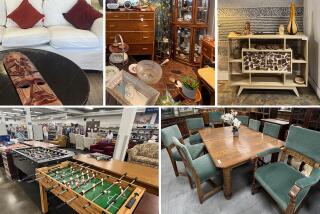The Secret Life of Furniture : OBJECTS OF DESIRE: The Lives of Antiques and Those Who Pursue Them, <i> By Thatcher Freund (Pantheon: $24; 291 pp.)</i>
The urge to collect starts early in life--one Barbie doll soon leads to another and another, and, before you know it, youâve got a whole drawerful of the 11 1/2-inch arched-eyebrowed, plastic, pony-tailed teen-agers. A hobby has become a habit.
There are no bounds when it comes to collecting. All you need is the courage of your convictions and a little cash, or a lot, if you are one of the people who flock to New York every January for the Americana auctions and the Winter Antiques Show on Park Avenue held the same week. A dealer spends as much as $30,000 in fees to sell at the glitzy Americana show. This is actually cheap, considering the number of people who might spend $1 million on a single piece of American furniture, including Eddy Nicholson, former chairman of the Congoleum Corp., actor Bill Cosby and Dallas billionaire Robert Bass, who once paid $12.1 million for a Newport secretary-bookcase. Even with $30,000, itâs not easy to become a seller at that show: A dealer currently exhibiting there would first have to die.
In âObjects of Desire: The Lives of Antiques and Those Who Pursue Them,â Thatcher Freund focuses on three pieces of 18th-Century American furniture on offer during a single day in January, 1991: a blue blanket chest that once stored socks and underwear, offered at the Winter Antiques Show for $245,000; a rare ball-and-claw-foot Chippendale card table, forgotten for 60 years in a dark basement until the grandson of its original owner discovered it, estimated to bring $1 million at the Americana auction at Sothebyâs, and a federal inlaid, drop-leaf sofa table, a prized piece from a Massachusetts collector forced by the recession to sell his antiques, valued at $100,000, also on display at Sothebyâs.
âThings lead lives like people do,â writes Freund (ungrammatically!), âand they prosper, like people, on the strength of their character.â
While âObjects of Desireâ is partly about antiques and immortality, it is really a story about collectors and why theyâll do practically anything to remain in the hunt. Judging from the cast of characters Freund introduces, you get the impression that a prized table is no different from a prized terrier. Whatâs really at stake are egos, and the need to win.
Freund writes about Joseph Hirshhorn, the 5-foot, 3-inch uranium magnate, who would shout: âHow much is this? How much is this? How much is that? How much for the whole lot?â and buy 40 or 50 things at once. He writes about Connecticut antiques dealer David Schorsch, who shopped at Mr. Guy of Beverly Hills because thatâs where Jeopardy host Alex Trebeck got his clothes. A blockfront-furniture expert by the age of 7, Schorsch paid outrageous prices for American folk art just to get people to notice him.
Great antiques, like great dogs, are valued for provenance. And certain collectors and dealers trade on that allure. About Mario Buatta, the âPrince of Chintzâ decorator who single-handedly turned the Winter Antiques Show into a major social event, Freund describes a panel discussion Buatta moderated. Three hundred women paid $35 a piece to listen to famous decorators discuss decorating with antiques. â(The ladies) seemed to care less about what made one antique unique and another not, than about the way such things fit together. They wanted history right then. They didnât want to wait two hundred years to have it. Mario Buatta was happy to oblige. He knew it was his job not to help others connect to the past, but to invent a past. âA lot of us didnât inherit these things,â he explained that day to his admirers. âBut we want our houses to look that way. Thatâs what we all want to strive for.â â
The author knows it too. He also knows certain individuals will do just about anything to buy--and even more to sell--a piece of the past. He tells of auctioneers who pretend to have other bidders when there are none. He tells of how a Sothebyâs deal with an old-monied family to sell the $1 million card table required full-page color ads of the table in antique magazines, a meal to be served to the family by Sothebyâs chef Bernard, a suite of four rooms to be taken at the Carlyle Hotel and catalogues to be mailed free to the widow for life. He writes about dealers who distract the competition at auctions to keep prices down. And he describes how some Ohio dealers discovered that while they had no trouble finding antiques made by Ohio craftsmen, few people actually wanted them; âAs a result . . . when clients asked about a piece, the dealer would sometimes say, âThe people who owned it moved from Pennsylvania.â â
The book has its faults. Freund plows back and forth in time, filling in the historical gaps with theories. Instead of identifying the owner of the Chippendale table, Freund refers to him coyly as âa man whom we will call Tom Hughes. The Hugheses come from the sort of old Philadelphia family that prefers not to see its name printed in any context besides those of marriage and death, and asks researchers to oblige.â Oh, really. And perhaps they got no thrill from seeing their furniture biographied in this book?
And where are the pictures? Two of the pieces of furniture are shown on the jacket, but the other is covered in sheeting. It would be nice also to see what some of the collectors and dealers look like.
Freundâs portrait of the antiques world--the craftsmen, the wealthy, eccentric collectors, the rough, competitive dealers characterized by ego and obsession is a clever examination of an incurable disease. Reading about antiques, though, is not nearly as much fun as buying them. Still, itâs better than having to walk a Schnauzer.


